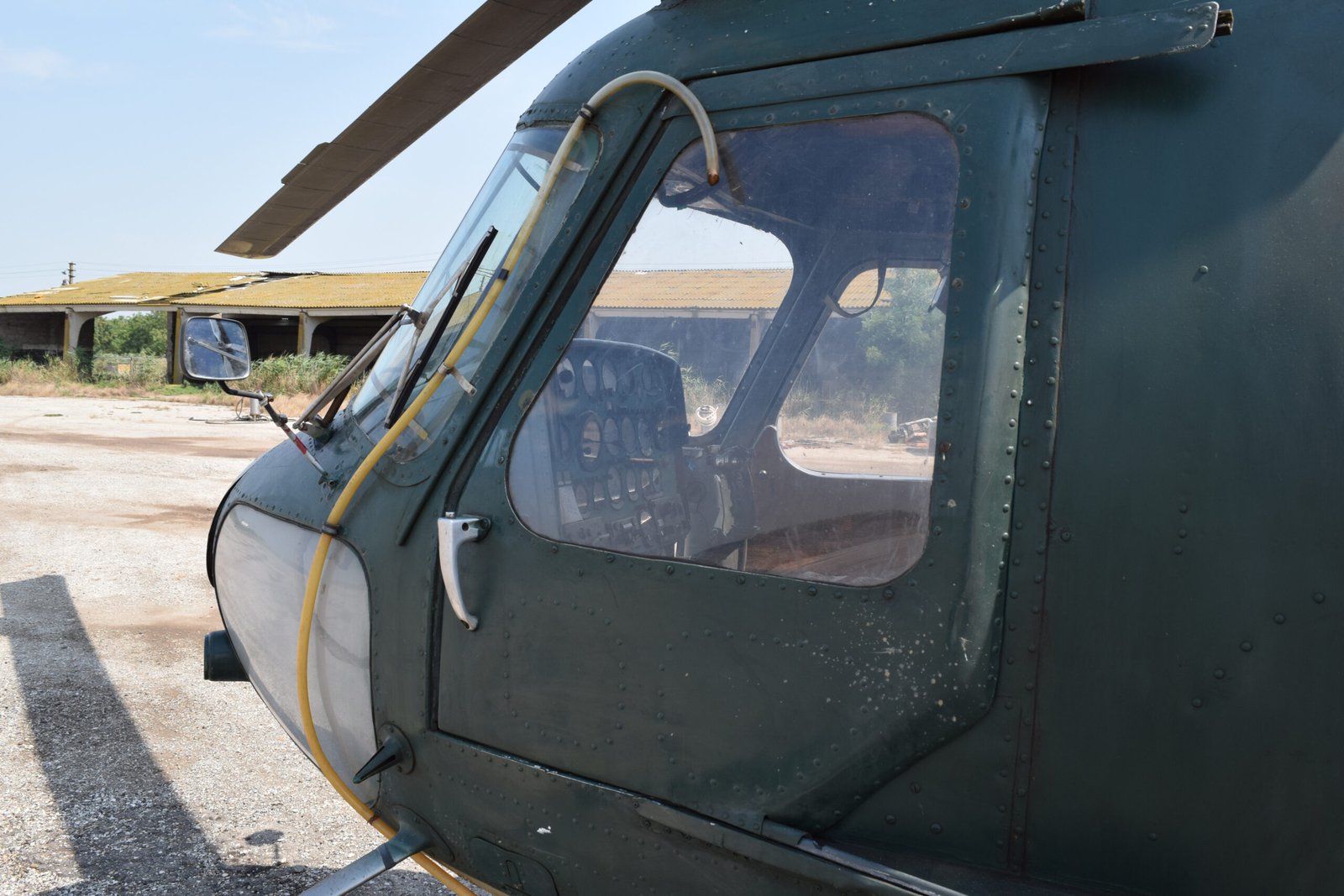FAA Regulations
The Green Skies Ahead: Sustainable Innovations in Aviation
As the aviation industry continues to evolve, sustainability has emerged as a critical focus. With increasing awareness of environmental impacts, innovative solutions are being developed to reduce carbon footprints and promote greener practices. To navigate this transformative landscape, aspiring aviators can access various educational resources tailored to their interests and career goals.
*Aviation Schools by Types of Courses**
The journey into aviation begins with education, and there is an abundance of options available for those eager to take flight. Aviation schools offer diverse programs catering to different aspects of the field:

1. **Pilot Training Programs**: These courses focus on the technical skills needed to operate aircraft. From private pilot licenses (PPL) to commercial pilot licenses (CPL), students gain hands-on experience that prepares them for real-world flying.
2. **Air Traffic Control**: Specialized curricula teach students how to manage air traffic safely and efficiently. Graduates play a crucial role in maintaining orderly skies while ensuring flights operate smoothly.
3. **Aviation Management**: For those interested in the business side of flying, aviation management courses cover topics such as airport operations, airline marketing, and logistics—essentially everything needed for running successful aviation enterprises.
4. **Aircraft Maintenance Engineering**: This program equips students with the knowledge required to troubleshoot and repair aircraft systems. As sustainable technologies emerge, understanding new eco-friendly materials becomes increasingly vital.
5. **Unmanned Aerial Systems (UAS)**: With the rise of drones, many institutions now offer courses focused on UAV technology, regulations, and applications—a rapidly growing sector within aviation.
Exploring these varied pathways provides prospective aviators with rich opportunities aligned with their passions while contributing positively to industry sustainability.
*Lists of Aviation Blogs, Websites, Social Media Sites**
Staying informed about the latest advancements in sustainable aviation practices is essential for both professionals and enthusiasts alike. Here’s a compilation of valuable online resources:
**Aviation Week Network**: A leading source for news covering all aspects of aerospace innovation.
**FlightGlobal**: An extensive database offering insights into airlines’ efforts toward sustainability.
**The Air Current**: Focuses on news analysis related specifically to market shifts in airlines aiming for greener operations.
**Simple Flying Blog & Site**: Offers updates on current events along with expert opinions on how airlines can innovate sustainably.
**Reddit’s r/flying Community**: A vibrant forum where pilots share experiences and discuss eco-friendly practices in aviation.
Additionally, popular social media platforms like Twitter (#AvGeek) or Instagram provide a visual feast featuring stunning aircraft photos alongside discussions about sustainability trends within the community.
*FAA Flight Schools/Airplane Schools/Simulators**
For those ready to take action towards becoming licensed pilots or specialists in other areas of aviation, FAA-approved flight schools remain indispensable resources. These institutions uphold rigorous training standards that ensure safety while equipping students with crucial skills.

Many FAA flight schools offer advanced simulators that mimic real-life flying scenarios—perfecting techniques without leaving the ground! Simulators not only minimize fuel consumption but also allow trainees from diverse backgrounds unlimited opportunities for practice without environmental impact concerns.
In conclusion, as we gaze upon the horizon marked by promising green skies ahead, it’s clear that sustainable innovations are reshaping our beloved industry. By diving into educational avenues and utilizing available resources—be it blogs or reputable flight schools—we can actively participate in creating a more environmentally responsible future for aviation! So buckle up; it’s going to be an exciting ride!
From Runway to Reality: The Transformative Power of Drones
In the realm of aviation, the intersection of technology and training has reached unprecedented heights. The evolution from traditional flight methods to modern innovations like drones illustrates a transformative journey that reshapes both our skies and our training methodologies. As we delve into this airborne revolution, it becomes clear that embracing technology is not just optional; it’s essential for anyone aspiring to soar in the aviation world.

First and foremost, simulators have revolutionized aviation training. Gone are the days when aspiring pilots solely relied on hours spent in real aircraft. Today’s sophisticated flight simulators replicate every conceivable scenario a pilot might face, providing a safe environment for skill enhancement. These simulators range from basic to highly advanced systems, enabling pilots to practice everything from routine takeoffs to emergency landings without risking lives or equipment. This immersive experience cultivates confidence, sharpens decision-making skills, and facilitates better retention of knowledge—making it a cornerstone of modern pilot education.
For those seeking insight into the vast landscape of aviation commentary and expertise, numerous blogs and websites serve as invaluable resources. Sites like *Airliners.net* offer forums for discussion among aviation enthusiasts, while *The Points Guy* provides tips on maximizing travel rewards—highlighting how various technologies can enhance air travel experiences. Additionally, social media platforms such as Instagram and Twitter buzz with accounts dedicated to aviation photography and industry news. Accounts like @AviationDaily or @PilotVlogs engage followers with captivating visuals and updates about current events in the aviation sector.

Recognizing the need for continuous learning in this rapidly evolving domain is crucial. Online aviation courses have surged in popularity, making education accessible regardless of geographic location. Institutions like Embry-Riddle Aeronautical University offer comprehensive ground schools that cater to all levels—from novice flyers to seasoned professionals looking to update their skills amidst technological advancements. Platforms such as Coursera feature specialized courses on drone operations or aerodynamics that allow learners flexibility while diving deep into complex subjects at their own pace.
With this technological boom comes a plethora of job opportunities within the field—especially for pilots trained in drone operation. According to recent FAA reports, commercial drone usage is projected to grow exponentially over the next decade across various sectors including agriculture, real estate, emergency services, and logistics. This demand creates an enticing career path for those who already possess piloting skills or seek certification specifically tailored toward unmanned aerial vehicles (UAVs).
Navigating this new terrain requires understanding regulatory guidelines set forth by authorities like the Federal Aviation Administration (FAA). Their website serves as an essential resource where budding pilots can find information on licenses needed for drone operators alongside safety regulations necessary for compliant flying practices. The FAA’s Remote Pilot Certification program ensures that individuals are well-versed in operating drones safely while following established protocols—a vital component in promoting responsible use as this technology proliferates.
In conclusion, as we transition from runways crafted for manned flights towards expansive skies ripe with possibilities offered by drones, embracing these innovations leads us toward exciting futures within aviation careers—ones filled with endless opportunities for growth and exploration. The synergy between technology training via simulation and online coursework encapsulates a commitment to excellence that will undoubtedly shape tomorrow’s aviators into pioneers ready to navigate uncharted territories above us all!
From Runways to Skyways: The Impact of Airport Infrastructure on Global Travel
In today’s interconnected world, the aviation industry stands as a vital pillar of global travel. Behind the scenes, robust airport infrastructure plays a crucial role in ensuring that we can traverse continents within hours. But the story does not end with runways and terminals; it extends into technology training, online resources, and even the burgeoning field of drones. Let’s explore how these elements intertwine to shape modern travel.
At the heart of aviation’s evolution lies technology training. Modern pilots undergo rigorous simulations that replicate real-world flying scenarios without ever leaving the ground. Flight simulators are not just toys for aspiring aviators; they’re sophisticated tools that allow trainees to experience a variety of conditions and emergencies in a controlled environment. This level of preparedness is essential when you consider that safety is paramount in air travel.
For those eager to dive deeper into aviation knowledge, numerous blogs and websites serve as treasure troves of information. A few notable mentions include Flying Magazine, AirlineReporter.com, and The Points Guy. Each offers unique insights—from technical analyses of aircraft systems to tips for maximizing frequent flyer miles. Social media platforms also foster vibrant aviation communities where enthusiasts can share their experiences and expertise. Twitter accounts like @AviationWeek or Instagram profiles dedicated to aircraft photography provide daily doses of inspiration for both professionals and hobbyists alike.
If you’re considering embarking on a career in aviation, there’s never been a better time to take advantage of online courses and ground schools tailored specifically for budding pilots. Websites such as Pilot Institute offer comprehensive programs covering everything from private pilot certification to advanced instrument ratings—often at your own pace! These flexible options make it easier than ever to fit education into your busy schedule while pursuing your dream job.
The demand for skilled pilots continues to rise, driven by an uptick in global travel post-pandemic and an increasing number of airlines launching new routes. However, aspiring aviators must also stay abreast of regulatory requirements set forth by authorities like the FAA (Federal Aviation Administration). Their website is an invaluable resource for understanding licensing procedures, safety regulations, and ongoing training mandates.

As we look towards the future, one cannot overlook the growing influence of drones in both commercial applications and recreational hobbies. Drones are revolutionizing logistics—think about how packages zip through the skies instead of being stuck in traffic! This innovative technology has led regulators like the FAA to develop guidelines that ensure safe operation alongside traditional air traffic. For those interested in joining this dynamic sector, various online courses teach drone piloting fundamentals while covering regulatory compliance—a must-have skill set as this field expands rapidly.
With advancements continuing at breakneck speed across all facets of aviation—from new aircraft designs to evolving airport technologies—the industry’s landscape remains exciting and unpredictable. As travelers become more discerning about their experiences, airports will need to adapt accordingly by investing in modern amenities that enhance comfort while optimizing efficiency.
In conclusion, whether you’re soaring above clouds as a pilot or simply enjoying your travels below them, understanding how airport infrastructure impacts global travel enriches our appreciation for this incredible industry. With every takeoff and landing facilitated by cutting-edge technology and well-trained professionals—all made possible through rigorous training programs—we’re witnessing history unfold one flight at a time!
A Bird’s Eye View: The Evolution of Commercial Aviation
The skies have always captivated humanity, and the evolution of commercial aviation has transformed our world in remarkable ways. From the early days of flight to today’s high-tech aircraft, advancements in technology and training have played a pivotal role in shaping the industry.
One area that has seen tremendous growth is aviation technology training. Modern pilots are no longer solely reliant on hands-on experience; they now hone their skills using advanced flight simulators. These sophisticated devices replicate real-life flying conditions, allowing aspiring aviators to practice maneuvers and troubleshoot emergencies without ever leaving the ground. Training programs incorporate various scenarios, from routine take-offs to challenging weather conditions, ensuring pilots are well-prepared for anything that may come their way.
For those looking to delve deeper into aviation knowledge, there’s an abundance of resources available online. Numerous blogs and websites cater to enthusiasts and professionals alike. Websites like AirlineReporter.com and TheAviationist.com offer insights into industry news and trends, while FlightGlobal.com provides comprehensive analysis on global aviation developments. Social media platforms also abound with aviation content; Twitter accounts such as @AviationWeek deliver timely updates, while Instagram is bursting with stunning aerial photography capturing the beauty of flight.
Moreover, online aviation courses have revolutionized how individuals pursue their passion for flying or seek careers in this dynamic field. Ground schools now offer flexible options for students around the globe—be it through interactive modules or live sessions with seasoned instructors. These courses cover essential topics ranging from navigation and meteorology to regulations governing airspace usage. They provide a solid foundation for aspiring pilots who wish to turn their dreams into reality.

In addition to traditional pilot roles, commercial aviation offers a variety of job opportunities within its expansive ecosystem. Whether you aim to be a commercial airline captain or an air traffic controller guiding flights safely through busy airspace, the demand for skilled professionals continues to rise. Resources such as FAA.gov serve as excellent starting points for understanding licensing requirements and career paths available in this field.
As we traverse further into this decade, one cannot overlook the impact of drones on the future of aviation. Once merely a novelty gadget for hobbyists, drones are now essential tools across numerous industries—from agriculture monitoring to disaster response efforts. The FAA is actively involved in regulating these unmanned aircraft systems (UAS), ensuring safety standards are met while promoting innovation within this burgeoning sector.
To stay informed about changes affecting both manned and unmanned flight operations, it’s vital to keep up with official resources like FAA links that provide updates on regulations and new technologies entering the market.
The trajectory of commercial aviation showcases not just technological marvels but also our collective ambition as humans striving for progress. Whether you’re an aspiring pilot mastering your skills through simulators or someone exploring drone technology’s potential impact on our lives, there’s never been a more exciting time to engage with this vibrant industry.
From ground school courses laying down foundational knowledge to blogs offering daily nuggets of wisdom about contemporary issues facing aviation today—the possibilities are endless! So fasten your seatbelts; we’re just getting started on this exhilarating journey through the skies!
Green Skies Ahead: How Sustainable Practices Are Changing Air Travel
As the world grapples with climate change, the aviation industry is rising to the challenge by embracing sustainable practices that are reshaping air travel. With advancements in technology and training, the skies are set to become greener than ever.
One of the most significant developments in aviation is the integration of advanced technology into pilot training. Flight simulators have revolutionized how aspiring pilots learn. These sophisticated systems provide realistic environments that mimic various flying conditions without the environmental impact of traditional flight training. Pilots can practice emergency procedures or complex maneuvers in a controlled setting, ensuring they are well-prepared for real-world scenarios while minimizing their carbon footprint.
For those keen on keeping up with industry trends, there’s a wealth of information available online. Numerous aviation blogs and websites offer insights into sustainability efforts within the sector. Sites like AvWeb and Flying Magazine provide regular updates on innovations, regulatory changes, and environmental initiatives. Social media platforms such as LinkedIn and Twitter feature groups dedicated to sustainable aviation discussions, allowing enthusiasts to connect and share ideas about reducing emissions and enhancing efficiency.

Moreover, an array of online courses is now accessible for individuals interested in pursuing careers in aviation or expanding their knowledge base. Ground schools offer foundational education for both aspiring pilots and those working behind the scenes at airports or airlines. Platforms like Coursera and Udemy host comprehensive courses covering everything from aerodynamics to air traffic control fundamentals. Such educational resources play a crucial role in preparing future professionals who will be at the forefront of sustainability efforts.
The demand for skilled pilots continues to rise as air travel rebounds post-pandemic; however, prospective aviators must also be equipped with knowledge about green technologies. Airlines are increasingly looking for candidates who understand eco-friendly practices—be it operating fuel-efficient aircraft or employing strategies that reduce waste during flights.
In addition to traditional piloting roles, new opportunities are emerging within the realm of drones—a sector poised to transform logistics and delivery services while minimizing environmental impact. Drones can efficiently transport goods over short distances without contributing significantly to carbon emissions associated with conventional transportation methods. As regulations evolve, so too do job prospects in this exciting field.
For anyone involved in aviation or simply interested in its trajectory toward sustainability, staying updated on FAA regulations is imperative. The Federal Aviation Administration (FAA) has been actively promoting initiatives aimed at reducing greenhouse gas emissions through innovative technologies like sustainable aviation fuels (SAF). Their website provides valuable resources detailing guidelines for implementing these practices across various sectors of aviation.
In conclusion, as we navigate toward greener skies, it’s clear that innovation plays a pivotal role in shaping the future of air travel. From enhanced pilot training through simulators to embracing cutting-edge drone technology and staying informed via diverse online platforms—every aspect contributes towards making our skies cleaner and more sustainable than ever before. Embracing these changes not only benefits our planet but also opens up exciting avenues for professionals passionate about shaping an eco-conscious future in aviation!




